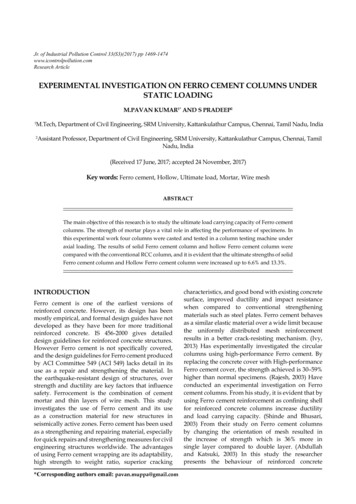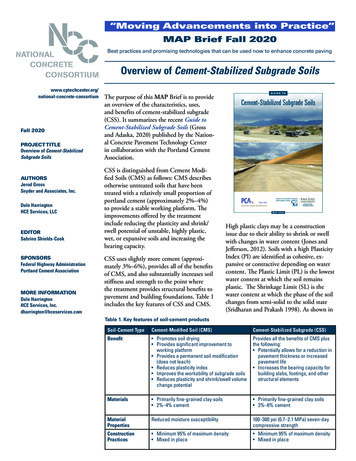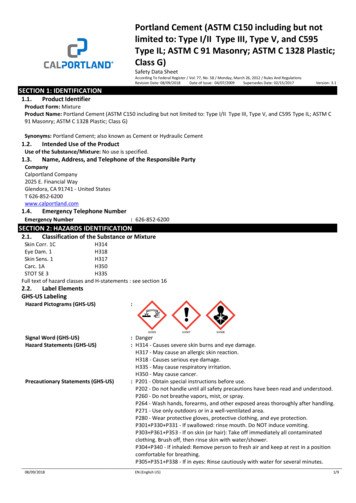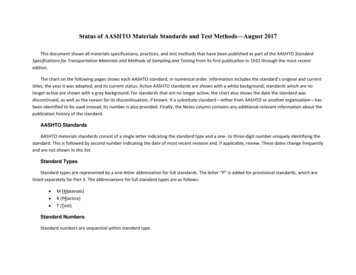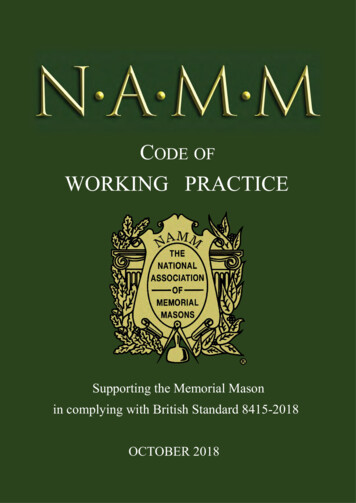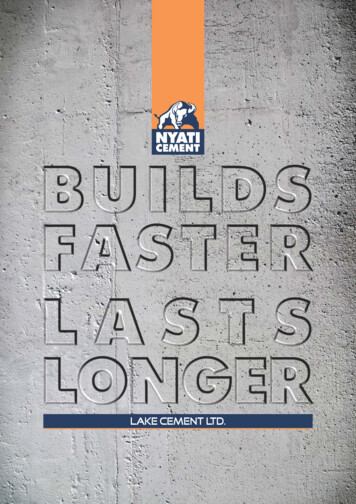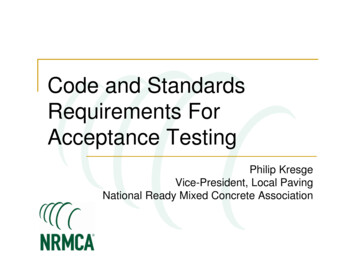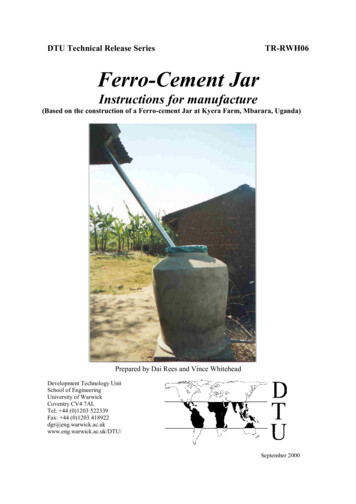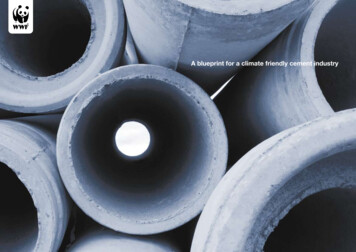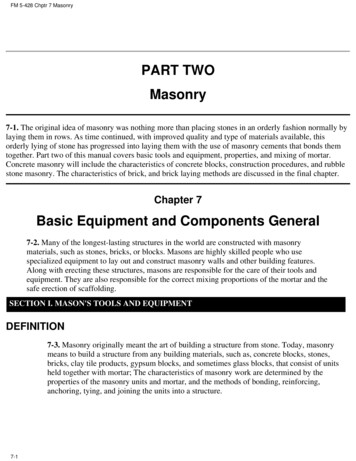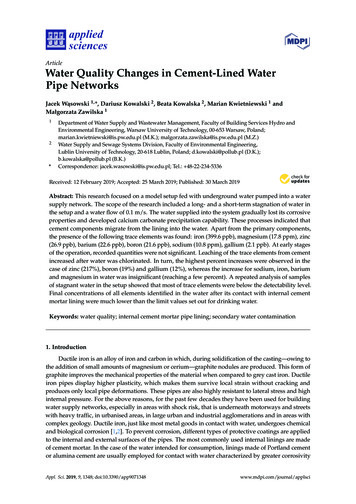
Transcription
appliedsciencesArticleWater Quality Changes in Cement-Lined WaterPipe Networks1, *, Dariusz Kowalski 2 , Beata Kowalska 2 , Marian Kwietniewski 1 andJacek Wasowski Małgorzata Zawilska 112*Department of Water Supply and Wastewater Management, Faculty of Building Services Hydro andEnvironmental Engineering, Warsaw University of Technology, 00-653 Warsaw, Poland;marian.kwietniewski@is.pw.edu.pl (M.K.); malgorzata.zawilska@is.pw.edu.pl (M.Z.)Water Supply and Sewage Systems Division, Faculty of Environmental Engineering,Lublin University of Technology, 20-618 Lublin, Poland; d.kowalski@pollub.pl (D.K.);b.kowalska@pollub.pl (B.K.)Correspondence: jacek.wasowski@is.pw.edu.pl; Tel.: 48-22-234-5336Received: 12 February 2019; Accepted: 25 March 2019; Published: 30 March 2019 Abstract: This research focused on a model setup fed with underground water pumped into a watersupply network. The scope of the research included a long- and a short-term stagnation of water inthe setup and a water flow of 0.1 m/s. The water supplied into the system gradually lost its corrosiveproperties and developed calcium carbonate precipitation capability. These processes indicated thatcement components migrate from the lining into the water. Apart from the primary components,the presence of the following trace elements was found: iron (399.6 ppb), magnesium (17.8 ppm), zinc(26.9 ppb), barium (22.6 ppb), boron (21.6 ppb), sodium (10.8 ppm), gallium (2.1 ppb). At early stagesof the operation, recorded quantities were not significant. Leaching of the trace elements from cementincreased after water was chlorinated. In turn, the highest percent increases were observed in thecase of zinc (217%), boron (19%) and gallium (12%), whereas the increase for sodium, iron, bariumand magnesium in water was insignificant (reaching a few percent). A repeated analysis of samplesof stagnant water in the setup showed that most of trace elements were below the detectability level.Final concentrations of all elements identified in the water after its contact with internal cementmortar lining were much lower than the limit values set out for drinking water.Keywords: water quality; internal cement mortar pipe lining; secondary water contamination1. IntroductionDuctile iron is an alloy of iron and carbon in which, during solidification of the casting—owing tothe addition of small amounts of magnesium or cerium—graphite nodules are produced. This form ofgraphite improves the mechanical properties of the material when compared to grey cast iron. Ductileiron pipes display higher plasticity, which makes them survive local strain without cracking andproduces only local pipe deformations. These pipes are also highly resistant to lateral stress and highinternal pressure. For the above reasons, for the past few decades they have been used for buildingwater supply networks, especially in areas with shock risk, that is underneath motorways and streetswith heavy traffic, in urbanised areas, in large urban and industrial agglomerations and in areas withcomplex geology. Ductile iron, just like most metal goods in contact with water, undergoes chemicaland biological corrosion [1,2]. To prevent corrosion, different types of protective coatings are appliedto the internal and external surfaces of the pipes. The most commonly used internal linings are madeof cement mortar. In the case of the water intended for consumption, linings made of Portland cementor alumina cement are usually employed for contact with water characterized by greater corrosivityAppl. Sci. 2019, 9, 1348; doi:10.3390/app9071348www.mdpi.com/journal/applsci
Appl. Sci. 2019, 9, 13482 of 11(lower pH value, low alkalinity and high CO2 content). External pipe surfaces are covered with zinc orzinc and aluminium coatings or with black varnish or epoxy plastic [3–5].The primary ingredient of the cement is Portland clinker, its content—depending on cementtype—ranging from 95% (additive-free Portland cement) to 15% (blast-furnace cement). Portlandclinker is the product of heating (sintering) the mixture of limestone and aluminosilicate materialsat the temperature of about 1450 C. Primary elements contained in the cement include silicon,calcium, aluminium, iron and sulphur, possibly complemented with potassium, titanium, magnesium,manganese and phosphorus. During fuel combustion in rotary furnaces, some amount of heavymetals contained in the fuels are accumulated in the clinker. In recent years, different types of wastematerials have been combusted in these furnaces, such as used motor oils or car tyres, which may havesignificantly higher heavy metal content than natural raw materials.Elements contained in the primary components of the cement coating released into water inmost cases do not affect its health claims. They do, however, have some impact on its organolepticproperties such as taste, odour or turbidity. Leaching of mechanical impurities, such as sand, may leadto corrosion of the fittings and any other components of water supply networks and systems [6–8].Examination of damage to new cement coatings caused by water with varied corrosive propertiesconducted by Douglas and Merill [9] showed that low-alkalinity aggressive water may significantlyraise pH (from 7 to 12 after one week of testing), alkalinity and calcium content in water contactingcement mortar coatings. Application of a bitumen coating covering the cement layer considerablyreduces the solubility of cement components [9]. Vik and Hedberg [10] listed the following waterquality parameters that are recommended to be met in order to prevent dissolution of cement-basedmaterials, including asbestos cement, cement pipes and cement coatings: pH 7, alkalinity 15 mg/Lin the form of CaCO3 , calcium 10 mg/L, sulphates 200 mg/L, aggressive CO2 5 mg/L.Trace elements such as chromium, lead, zinc, nickel, arsenic, cadmium, vanadium or copper [11]are released from the cement lining into the water flowing through the pipeline. A study examiningthe leaching of trace elements from the cement, conducted by Achternbosch et al. [12] also showedthat the use of waste materials for clinker firing increases element cement content to a minor extent.Reported relationships were not clear-cut however, as they were influenced by many factors, includingmethod used and solubility testing. The study by van der Sloot [13] presented leaching of metals fromcement mortar as a function of pH and duration of the period in which cement was in contact withwater. Based on the revealed relationships, it was observed that the smallest amounts of metals leachedinto the water when it was neutral. Guo et al. [14] observed increased amounts of chromium, arsenic,barium and cadmium leached from the cement coating, recording their concentrations above the limitvalues for drinking water. Analyses conducted by Moudilu et al. revealed a correlation betweenleaching of heavy metals from the Portland cement and temperature, as well as the period of theexperiment, using a new, highly sensitive method that allowed to determine very low concentrationsof these elements [15]. Use of cement mortar coatings may lead to penetration of aluminium into thewater, with the aluminium content depending on the type of cement. After two months of experimentson steel pipes with cement mortar lining, aluminium content was found to increase from 0.005 mg/dm3to 0.690 mg/dm3 . This element affects human health and it is particularly dangerous for patientsundergoing kidney dialysis [16]. Due to the fact that the leaching of aluminium from Portland cementoccurs in low-alkalinity water, Berend et al. [16] recommend that internal coatings made in situ fromregular Portland cement should not be used in water with an alkalinity lower than 55 mg/L as CaCO3and that factory-made internal cement coatings should not be used in water with alkalinity lowerthan 25 mg/L as CaCO3 . It is also recommended that the use of high alumina cement lining shouldbe limited in pipelines used for distributing drinking water, due to much higher aluminium contentleached from this type of cement into the water, when compared to Portland cement [3,6].The discussed topic is not new. However, previous studies focused on the laboratory, mainlystatic, leaching tests. This paper presents new studies conducted under real dynamic conditions, basedon a new 90 m experimental set. The hydraulic conditions in this set reflected the average conditions in
Appl. Sci. 2019, 9, x3 of 11based on a new 90 m experimental set. The hydraulic conditions in this set reflected the averageconditions in the entire network, determined on the basis of field measurements and numericalcalculations (using a numerical model devised in EPANET 2.0 software, US EPA, Washington D.C.,Appl. Sci. 2019, 9, 13483 of 11USA, 2000).In this paper, the composition of cement lining was connected with the changes in the quality ofwatertransmittedvia lined pipeline.The occurrenceof changes andin thewater qualitywas indicatedtheentirenetwork, determinedon the basisof field measurementsnumericalcalculations(using aboth in ANET (daily).2.0 software, US EPA, Washington D.C., USA, 2000).Theavailableliteratureoffers ofnocementexhaustiveon theimpactof cementmortarliningInthispaper, thecompositionlininginformationwas connectedwiththe changesin thequalityofof waterconduitsviaon linedthe qualityof Thethe conveyedThis rencewater.of changesin becausethe waterthequalitywas indicatedwateris determinedbothin andshortcement(hourly)liningand long-term(daily).by many factors; a significant role is played by watercompositionandtypeofliningbutalso propertiesof the oncontactingwater.Also,mortarstate-of-the-artThe available literature offers no exhaustiveinformationthe impactof cementlining oflaboratorymethodsandofquiteoften fail water.to reflectconditionsfound inwater supplywaterconduitson thevaryqualitythe conveyedThisreal-lifeis becausethe ingtheand cement lining is determined by many factors; a significant role is played by water compositionexperimentalsetup,the main purposeof determiningthe impactof cementcoating methodscoveringandtype of liningbut withalso propertiesof the contactingwater. Also,state-of-the-artlaboratorythe internalsurfacewaterconduitmadeof ductileironinonwaterqualityin termsInoflightchangesinvaryand quiteoften ynetworks.of theitsphysico-chemicalproperties.above, this paper presents a properly designed study conducted using the experimental setup, withthe main purpose of determining the impact of cement coating covering the internal surface of a water2. MaterialsMethodsconduitmadeandof ductileiron on water quality in terms of changes in its physico-chemical properties.The study was conducted in an experimental setup composed of the main pumping station2. Materials and Methodssupplying a water supply network in a selected city (Figure 1). Water was abstracted from intakesTheinstudywas conductedin anformationsexperimentalsetupcomposedmain pumpingstationlocatedundergroundCretaceoususing8 wells,from 55ofto the70 metresdeep. Abstractedsupplyingwatersupply networkin a selectedcityout(Figure1). Waterwasabstractedfromintakeswater met atherequirementsfor drinkingwater setin WHO[17] eousformationsusingno8 wells,from 55 to 70 metres deep. Abstracted[18] andinexceptfor periodicchlorination,it requirestreatment.waterThemet experimentalthe requirementsfor wasdrinkingwaterset out ironin WHO[17]andaPolishsetupmadeof ductilepipeswithtotal Nationallength ofStandards80 m and[18]an3andexceptfor periodicit requiresno treatment.internaldiameterof 65 chlorination,mm. The workingvolumeof the experimental setup was 250 dm ;stand;1—a1- a setset ,L 1.2m,4—splitter,asetof galvanizedII-nd degree, 2 - valve φ50, 3 - pipe, galvanized steel φ 50 mm, L 1.2 m, 4 – splitter,a set offittingsφ50, fittings5—socketfor5 sampling,φ15,6—ball φ15,valve6 φ50 mm,7—valveφ65,of thegalvanizedφ50,- socket forsampling,- ballvalveφ 50 mm,7 -8—partvalve φ65,8 -ductilepart ofironpipe forironthepipemicrobiologicaltesting withcementthe ductilefor the microbiologicalφ65, 9iron- ductilelinedwith mortar,cementLmortar, 80 m.L 80 m.The experimental setup was made of ductile iron pipes with a total length of 80 m and an internalThe study was composed of three testing series:diameter of 65 mm. The working volume of the experimental setup was 250 dm3 .Series I—long-term (multiple day) stagnation of water in the setup. Duration of the series untilThe study was composed of three testing series:stabilisation of water quality in the setup. Water samples were collected once a week.Series I—long-term (multiple day) stagnation of water in the setup. Duration of the series untilSeries II—short-term (few hour) stagnation of water in the setup. Water samples were collectedstabilisation of water quality in the setup. Water samples were collected once a week.from the setup after 0, 1, 2, 4, 8, 16 and 32 hours.Series II—short-term (few hour) stagnation of water in the setup. Water samples were collectedfrom the setup after 0, 1, 2, 4, 8, 16 and 32 h.Series III—water flow through the installation at the velocity of 0.1 m/s. Water samples for theanalyses were collected during the supply and drainage of the water from the setup, consideringretention times of the water in the pipeline.
Appl. Sci. 2019, 9, 13484 of 11The experimental setup was chlorinated and washed before every series. Before each seriesof measurements, a water sample was collected in order to determine the initial conditions.Physico-chemical analyses of water samples determining changes in its quality were conductedin accordance with applicable analytical standard methods. The standards according to whichthe measurements of particular water quality parameters were conducted are presented in Table 1.The analysis of every water quality parameter in each sample was performed in triplicate and theaverage of the results are presented in the tables. Trace element content in the water and in thecement coating was measured using the JY238 Ultrace Inductively Coupled Plasma—Optical EmissionSpectrometer (ICP-OES) (Jobin Yvon-Horriba, Montpellier, France) [19]. The calibration solutionswere prepared using CentiPUR VIII multi-element calibration solution (Merck group, Darmstad,Germany, 2013). In order to conduct a more accurate quantitative determination of elements, theinvestigations were carried out in two phases. In the initial phase, a fast semi-quantitative analyticmethodology was employed. This phase, as well as the previous results of studies on cement lining,enabled the determination of the elements that had to be subjected to further quantitative indicationwith a more accurate method (second phase). In that phase, determination was carried out by meansof inductively coupled plasma mass spectrometer (ICP-MS, 7700x, Agilent, Polo Alto, USA). Similar tothe initial phase, the quantitative determinations were performed using calibration curves and thesame pattern. The scope of analytical control of water samples is presented in the tables containingresults of relevant analyses.Table 1. Quality of the water feeding the experimental set-up.ParameterNo 1No 2No 3No 4No 5Limit Valuefor DrinkingWater [17,18]SampleUnitStandard sscalcium Cmg Pt/LNTUmval/Lmval/Lmg 57.116.28.21221516.5 9.51.2 10-ironmg ateschemical oxygendemandammonium ionnitratesfree CO2aggressive CO2oxygendry residuemg Mn/Lmg Cl/Lmg SO4 20.05250250PN EN ISO 7887:2012PN EN ISO 7027:2003PN EN ISO 100523:2012PN EN ISO 9963-1:2001PN ISO 6059:1999EDTA MethodPC MultidirectMethod 220HACH Method 8149PN ISO 9297:1994HACH Method 8051mg O2 /L1.21.34.61.80.85PN-74/C-04578-03mg H4 /Lmg O3 /Lmg/Lmg/Lmg O2 d5.35210.550-HACH Method 8038HACH Method 8039PN -74/ C-04547/01PN -74/ C-04547/03Winkler MethodPN -75/ C-04616/013. Results3.1. Analysis of Test Results for Water Feeding the Setup, Considering Its Corrosive PropertiesBased on the obtained results of the physico-chemical analysis (Table 1), it may be found that thesetup for the entire period of the experiment was fed with water of variable quality due to employmentof different wells in the intake. Changes in carbon dioxide and dry residue concentrations, that is,parameters significant in terms of corrosive properties of the water, are particularly clear. In general,feeding water had a pH approximating neutral (pH ranging from 6.90 to 7.53), very low colour (1 mg/L)and turbidity (from 0.45 to 0.89 NTU, single result of 1.04 NTU), as well as moderate salinity, which isprimarily reflected by the values of such indicators, as general hardness (6.8 8.2 mval/L), alkalinity(5.4 6.3 mval/L), chloride (17.8 39.0 mg Cl/L) and sulphate content (60 86 mg SO4 /L), as well
Appl. Sci. 2019, 9, 13485 of 11as dry residue content (358 542 mg/L). Iron concentration failed to exceed 0.10 mg/L (single resultof 0.24 mg/L was reported), whereas manganese concentration did not exceed 0.021 mg/L. Organicmatter burden may be regarded as relatively low due to the values of chemical oxygen demand(0.8 1.8 mg/L; single value of 4.6 mg/L), ammonium ion (0.005 0.141 mg/L) and nitrate ion(9.2 15.8 mg/L) indicators. The analysed water was reported to contain gas admixtures, such ascarbon dioxide with concentration ranging from 9.2 to 50.6 mg/L and oxygen (5.3 8.1 mg/L).When comparing the quality of the feeding water with standards set out for water for humanconsumption [17,18], it should be stated that in terms of compliance with these standards, the waterquality raised no concerns as regards the analysed physico-chemical indicators.The basic indicators used to approximately identify water impact on the cement coating are theRyznar Stability Index (RSI) and the Langelier Saturation Index (LSI), as well as an index proposedby American Water Works Association (AWWA) [20]. Additionally, some indicators referring tospecific water quality parameters may be determined, allowing evaluation of their impact on cementmortar lining. In order to provide a complete picture of the properties of water supplying theexperimental setup in terms of its chemical stability and corrosive properties in reference to typicalmetals used in constructing water distribution networks and systems, indices proposed by the technicalstandards [19–24] regarding impact of water on metallic materials were examined.Based on the analysis of the indices determining the chemical stability of the water (Table 2), it canbe concluded that, although water quality varied, it posed a minor hazard for cement and metallicmaterials. Only single results we obtained indicate some risk of corrosion. The only exception is theRyznar Stability Index, with values always within the range typical for aggressive water.Table 2. Corrosion indicators of the water feeding the experimental set-up.ParameterLangelier index (IL )Ryznar stability index (IR )AWWA index (IAWWA )Copperzinc-coatedironic materialscorrosion-resistantsteelsCast ironSS1S2SampleNo 3No 4No 5Small Risk ofCorrosion, When 0.040.08 0.400.237.147.027.707.0712.112.211.912.5corrosion indices for metallic materials8.18.19.05.80.40.40.40.611.012.79.610.6 0.097.2912.206.25 6.75 127.60.518.2 1.5 0.5 3No 1No 2c(Cl )0.50.50.60.91.1 1.5 mmol/Lc(O2 )pHc(HCO3 - )c(Ca2 .37.16.13.1 3 mg/L 7 2 mmol/L 1 mmol/LIL pH pHn, IR 2pHn pH, IAWWA pH log(AH) where: pH—real, pHn - saturation, A—alkalinity [mgCaCO3 /L]; H—calcium carbonate hardness [mg CaCO3 /L], c(HCO3 )—bicarbonate ion concentration [mmol/L];c(SO4 )—sulphate ion concentration [mmol/L]; c(Cl )—chloride iron concentration [mmol/L]; c(NO3 )—nitrateion concentration [mmol/L]. S, S1 , and S2 —calculated using following formulas:S c(HCO3 )c(SO24 ),S1 c(Cl ) c(NO3 ) 2c(SO24 ),c(HCO3 )S2 c(Cl ) 2c(SO24 )c(NO3 )(1)3.2. Analysis of Test Results for Multiple Day Stagnation of Water in The SetupThe first series assumed stagnation of water in the setup until stabilisation of its properties. In thisseries, water samples were collected once a week for 8 consecutive weeks. Changes in the values of themost significant water quality indicators over the experimental period presented in Table 3 providesvalues of the basic water stability indices in subsequent weeks of stagnation.
Appl. Sci. 2019, 9, 13486 of 11Table 3. Corrosive properties of the water during many weeks’ stagnation in the experimental set-up(series I).WeekILIRIAWWA01245678water stable for .496.646.486.746.25 6.7512.0912.2012.6712.8913.1313.2113.3913.15 12Obtained results show that over the stagnation period, water reacted with the cement coating forthe first 5 weeks. Over this period, a gradual increase in pH was observed (from 7.06 to 8.11), whichwas accompanied by carbon dioxide disappearance and increased water turbidity, chloride contentand in particular sulphate and dry residue content. During this period, alkalinity and water hardnesswas reported to increase to a lesser extent. Values of the Langelier Saturation Index (LSI) indicatedthat water introduced into the setup gradually lost its corrosive properties and the calcium-carbonatebalance was observed. The above-mentioned changes in water quality reflected gradual saturation ofthe water with cement coating components and an increasing water capability to precipitate calciumcarbonate deposits. Analyses of water stagnant in the setup over the subsequent period of the researchconfirmed this trend, which is especially emphasized by the reduced value of water turbidity, calciumconcentration and dry residue content. It should be emphasized that water quality over the entireexperimental period corresponded to the quality of water for human consumption, whereas values ofthe AWWA index showed that water could be safely used in contact with cement materials.3.3. Analysis of Test Results Obtained Over a Few-Hour Stagnation of Water in the SetupThe second series involved examination of water stagnant in the setup at time intervals of 1, 2,4, 8, 16 and 32 h. The sample used consisted of water found in the setup after about 11 months ofits operation. The tests were intended to show changes in water quality over a short-term contact ofwater (used in the water supply practice) with the cement coating covering the internal surface of theconduits. Results of physico-chemical analyses of water samples are presented in Table 4.Table 4. Corrosive properties of the water during stagnation period in the experimental set-up (series II).HourILIRIAWWA012481632water stable 626.626.496.25 6.7512.6412.6412.5612.6412.6812.7112.73 12Analyses of individual water samples show changes in water quality after prolonged contact withcement-mortar lining. The rate of these changes was very slow and they were related to penetration ofcement components found in the coating into the water; this mainly concerned calcium (aluminiumcontent remained very low and rather stable). Reactions between water and cement led to increasedturbidity, pH and gradual reduction of carbon dioxide content. As far as provisions concerningwater intended for human consumption are concerned, water turbidity had excessively high values.
Appl. Sci. 2019, 9, 13487 of 11Changes in the physico-chemical indicators of water quality were accompanied by changes in thevalues of stability indices. The increased Langelier Saturation Index and decreased Ryznar StabilityIndex reflected increased water capacity to precipitate calcium carbonate, whereas increased AWWAindex—safe use of the applied coating in case of contact with the examined water.3.4. Analysis of Test Results for Water Flowing through the Setup at the Velocity of 0.1 m/sThe third series was conducted under dynamic conditions, that is, water flowing throughthe experimental setup at a velocity of 0.1 m/s. This rate is commonly used in the currentlyover-dimensioned water supply networks. Water samples were collected after 11 months of using thesetup. During sampling, a 13-min long contact of water with the cement-mortar lining was considered.Results of the analysis for this series are provided in Table 5.Table 5. Quality of the water flowing through the experimental set-up at the velocity of 0.1 m/s(series III).ParameterUnitWater Feeding the SetupWater Flowing Outfrom the scalciumironmanganesechloridessulphatesoxygen consumptionammonium ionnitratesfree CO2oxygendry residueLangelier saturation index (IL)Ryznar stability index (IR)AWWA index Cmg Pt/LNTUmval/Lmval/Lmg Ca/Lmg Fe/Lmg Mn/Lmg Cl/Lmg SO4 /Lmg O2 /Lmg NH4 /Lmg NO3 /Lmg/Lmg O2 055039.0861.120.0915.839.66.935190.386.8212.67A comparison between the quality of water feeding the setup and water flowing out from thesetup shows that even after such short-term contact of water with the cement-mortar lining, underflow-through conditions there occurred an interaction between the water and the cement mortar lining.It should be stressed that changes in water quality proved minor, however they have already providedevidence of penetration of the basic cement components into the water. This increased the values ofbasic water quality indicators, including in particular turbidity, pH, hardness and dry residue contentand decreased carbon dioxide water concentration. Values of indicators determining water stabilitypoint out that during contact with cement mortar lining, the water increased its capability to precipitatecalcium carbonate.3.5. Determination of Trace Element Content in Water Contacting Cement-Mortar CoatingOn the basis of the results of the analysis of a sample cement coating covering the interior surfaceof the pipeline in the experimental setup using the Inductively Coupled Plasma—Optical EmissionSpectrometer (ICP-OES), it was found that, besides the primary cement components (including suchelements as potassium, sodium, magnesium, calcium, zinc, aluminium) it also contained numeroustrace elements such as iron, manganese, barium, chromium, lead, nickel and cobalt. Analyses of
Appl. Sci. 2019, 9, 13488 of 11chlorinated and non-chlorinated water contacting the cement-mortar coating conducted at the initialstage of setup operation (preliminary research) allowed to make a general statement that majority oftrace elements found in the cement were successfully immobilized and significant amounts failed topenetrate the water that contacted the coating. It should be stressed however, that leaching of traceelements from the cement was less intense in the case of chlorinated water [25].As part of the research presented herein, an attempt was made to analyse the phenomenon oftrace element penetration into the water after long-term use of the setup. To that end, after eightmonths of using the setup, another test for trace element water content was performed. The analysedsample consisted of water feeding the setup and water stagnant in the setup for 32 h. The resultsare presented in Table 6. The majority of trace elements (including those detectable in the water atthe initial stage of setup operation) were below the detection limit of the spectrometer. As regardselements detected in the stagnant water on the other hand, there was an insignificant increase in theirconcentration when compared to the water feeding the experimental setup, which was reported forsodium, magnesium, iron and barium. A slightly larger increase of about 19% was reported onlyin the case of boron concentration whereas there was a slightly lower increase of about 12% in thecase of gallium. A large (three-fold) increase was reported for zinc on the other hand, although itsfinal concentration in the stagnant water (0.027 mg/L) is still found to be rather low. It should bestressed that zinc content in drinking water is not limited by any Polish, American or internationalprovisions. All final concentrations of elements detected in the water after its contact with the coatingwere considerably below limit values for drinking water set out in relevant legal provisions.The reported small increases in their concentration is likely to occur for a number of reasons.The first one is the effective immobilisation of trace elements in the structure of the cement(their presence is confirmed, therefore their possible low content should be excluded). There arestudies [26,27] that proved that well-maintained cement provides for small leaching of hazardouselements, even if it contains an admixture of ashes obtained from incinerated hospital waste.The question of composition and maintenance of the cement intended to contact drinking watertherefore requires special attention. The second reason for a minor increase in metal water concentrationmay be the fact that the examined cement-mortar lining was in permanent contact with the water fora long time (8 months), therefore trace elements contained in the cement had already been leachedearlier (this is suggested by pr
of these elements [15]. Use of cement mortar coatings may lead to penetration of aluminium into the water, with the aluminium content depending on the type of cement. After two months of experiments on steel pipes with cement mortar lining, aluminium content was found to increase from 0.005 mg/dm3 to 0.690 mg/dm3. This element affects human .
